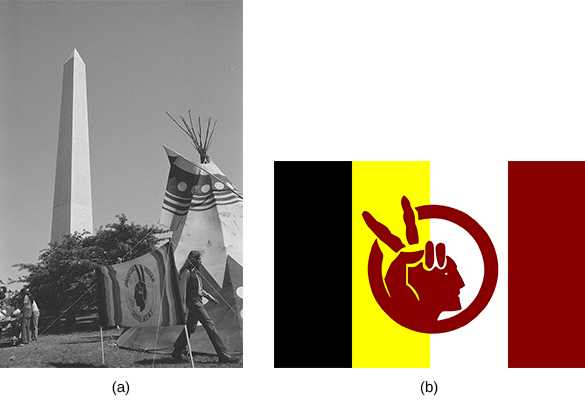| << Chapter < Page | Chapter >> Page > |

On November 20, 1969, a small group of Indian activists landed on Alcatraz Island (the former site of a notorious federal prison) in San Francisco Bay. They announced plans to build an American Indian cultural center, including a history museum, an ecology center, and a spiritual sanctuary. People on the mainland provided supplies by boat, and celebrities visited Alcatraz to publicize the cause. More people joined the occupiers until, at one point, they numbered about four hundred. From the beginning, the federal government negotiated with them to persuade them to leave. They were reluctant to accede, but over time, the occupiers began to drift away of their own accord. Government forces removed the final holdouts on June 11, 1971, nineteen months after the occupation began.
In occupying Alcatraz Island, Indian activists sought to call attention to their grievances and expectations about what America should mean. At the beginning of the nineteen-month occupation, Mohawk Richard Oakes delivered the following proclamation:
We, the native Americans, re-claim the land known as Alcatraz Island in the name of all American Indians by right of discovery.
We wish to be fair and honorable in our dealings with the Caucasian inhabitants of this land, and hereby offer the following treaty:
We will purchase said Alcatraz Island for twenty-four dollars ($24) in glass beads and red cloth, a precedent set by the white man’s purchase of a similar island about 300 years ago. . . .
We feel that this so-called Alcatraz Island is more than suitable for an Indian Reservation, as determined by the white man’s own standards. By this we mean that this place resembles most Indian reservations in that:
1. It is isolated from modern facilities, and without adequate means of transportation.
2. It has no fresh running water.
3. It has inadequate sanitation facilities.
4. There are no oil or mineral rights.
5. There is no industry and so unemployment is very great.
6. There are no health care facilities.
7. The soil is rocky and non-productive; and the land does not support game.
8. There are no educational facilities.
9. The population has always exceeded the land base.
10. The population has always been held as prisoners and kept dependent upon others.
Further, it would be fitting and symbolic that ships from all over the world, entering the Golden Gate, would first see Indian land, and thus be reminded of the true history of this nation. This tiny island would be a symbol of the great lands once ruled by free and noble Indians.
What does the Alcatraz Proclamation reveal about the Indian view of U.S. history?
Listen to Richard Oakes, one of the leaders of the Alcatraz Island occupation, as he reads the Alcatraz Proclamation aloud.

Notification Switch
Would you like to follow the 'U.s. history' conversation and receive update notifications?